Atmosphere
- Books Name
- Social Science Book
- Publication
- Cognizance Publication
- Course
- CBSE Class 7
- Subject
- Social Science
Chapter 4
Air
Atmosphere
A huge blanket of air that surrounds earth is called atmosphere. It provides us the air we breath and protect us from the harmful effects of the sun's rays which is essential for our survival. Without this blanket of protection we would be baked away by the heat of the sun during day and get frozen during night.So it is the mass of air that has made the temperature on the earth liveable.
Composition of the atmosphere
Nitrogen and oxygen are two gases which make up the bulk of the atmosphere.Carbon dioxide, helium, ozone organ and hydrogen are found in lesser quantities.Apart from these gases, tiny dust particles are also present in the air.Percentage of different constituents of air:-
Nitrogen 78%, Oxygen 21%, Argon 0.93%, Carbon dioxide 0.03% and all other 0.04%.
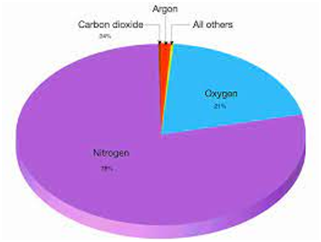
Nitrogen is the most plentiful gas in the atmosphere. When we inhale, we take some amount of nitrogen into our lungs and exhale it.Plants need nitrogen for their survival. They cannot take nitrogen directly from the air.Bacteria, that live in the soil and roots of some plants, take nitrogen from the air and change its form so that plants can use it.
Oxygen is the second most plentiful gas in the air.Humans and animals take oxygen from the air as they breathe.Green plants produce oxygen during photosynthesis, which make oxygen content in the air remains constant.If we cut trees, then this balance get disturbed.
Carbon dioxide is another important gas.Green plants use carbon dioxide to make their food and release oxygen.Humans or animals release carbon dioxide. The amount of carbon dioxide released by humans or animals is equal to the amount used by the plants, which make a perfect balance.However, the balance is upset by burning of fuels such as coal and oil,add billions of tons of carbon dioxide into the atmosphere each year.Which result in increased volume of carbon dioxide affecting the earth weather and climate.Carbon dioxide released in the atmosphere creates a greenhouse effect by trapping the heat radiated from the earth. It is therefore called a greenhouse gas. And without it, the earth would have been too cold to live in.However, when it's level in the atmosphere increases due to the factory smoke or car fumes, the retained increases the temperature of the earth. This is called global warming. This rise in temperature causes the snow in the coldest part of the world to melt.
As a result, the sea level rises, causing floods in the coastal areas. There may be drastic changes in climate of a place leading to extinction of some plants and animals in the long run.
When air is heated, it expands, becomes lighter and goes up. Cold air is denser and heavy. That is why it tends to sink down . When hot air rises, cold air from surrounding area rushes there to fill in the gap. This is how the air circulation takes place.
Structure of the Atmosphere
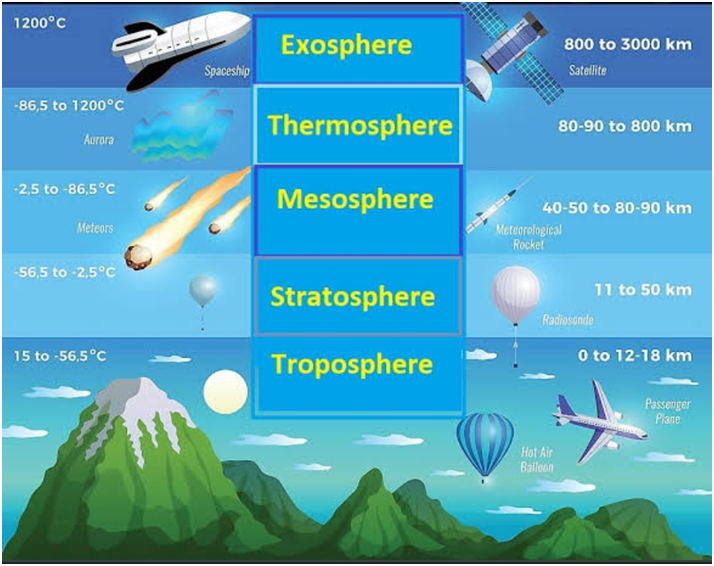
Our atmosphere is divided into 5 layers, starting from the earth surface. These are.Troposphere,Stratosphere, Mesosphere, Thermosphere, Exosphere.
Troposphere
It is the most important layer as the air we breathe existshere and almost all the weather phenomena like rainfall, fog and hailstorm occur in this layer.Its average height is 13 km.
Stratosphere
It lies above the troposphere.It extends upto the height of 50 km.This layer is almost free from clouds and associated weather phenomena, making conditions most ideal for flying aeroplanes. One most important feature of this layer is that it contains a layer of ozone gas which protect us from harmful effect of sun rays.
Mesosphere
This is the third layer of the atmosphere, which lies above the stratosphere.It extends upto the height of 80 km.Meteorites burn up in this layer on entering from the space.
Thermosphere
Temperature rises very rapidly with increasing height in this layer.Ionosphere is a part of this layer. It extends between 80-400 km. This layer helps in radio transmission.Radio wave transmitted from the earth are reflected back to the Earth by this layer.
Exosphere
The uppermost layer of the atmosphere is known as exosphere.This layer has very thin air.Light gases like helium and hydrogen float into the space from here.
Weather and climate
- Books Name
- Social Science Book
- Publication
- Cognizance Publication
- Course
- CBSE Class 7
- Subject
- Social Science
Weather and climate
Weather is this hour-to-hour, day today condition of the atmosphere.It can change dramatically from day today.The average weather condition of a place for a longer time period represents the climate of a place.
Temperature
The degree of hotness and coldness of the air is known as temperature.The temperature of the atmosphere changes not only between day and night, but also from season to season. An important factor that influences the distribution of temperature is insolation.Insolation is the incoming solar energy intercepted by the earth.The amount of insolation decreases from the equator towards the poles. Therefore the temperature decreases in the same manner. Temperature in cities is much higher than that of villages.The concrete and metals in buildings and the asaphalt of roads get heated up during the daywhich is released during the night. Also, the crowded high rise buildings of the citiestrap the warm air, and thus raise the temperature of the cities.
The standard unit of measuring temperature is degree Celsius. It was invented by Anders Celsius. On the Celsius scale the water freezes at 00 C and boils at 1000 C.
Thermometer measures the temperature.Barometer measures atmospheric pressure.Rain gauge measures the amount of rainfall.Wind vane shows the direction of the wind.
Air pressure
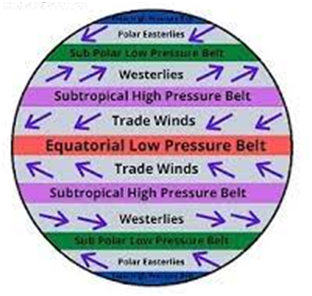
Air pressure is defined as the pressure exerted by the weight of air on the earth’s surface.As we go up the layers of atmosphere, the pressure falls rapidly.The air pressure is highest at sea level and decreases with height. Horizontally, the distribution of air pressure is influenced by temperature of air at a given place.In areas where temperature is high, the air gets heated and rises. This creates a low pressure area.
In areas having low temperature, the air is cold. It is therefore heavy.The air always move from high pressure areas too low pressure areas. On the moon, there is no air and hence no air pressure. Astronauts have to wear special protective spacesuits filled with air when they go to the moon. If they did not wear these space suits, the counter pressure exerted by the body of the astronauts would make the blood vessels burst.The astronauts would bleed.
Wind
The movement of air from high pressure areas to low pressure area is called wind.
The wind is named after the direction from which it blows. Example the wind blowing from the West is called westerly.
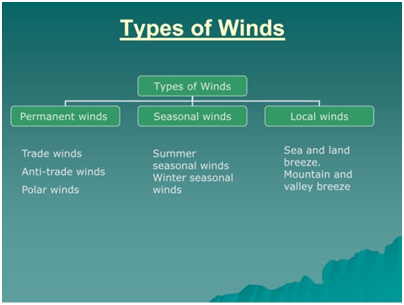
Wind can be broadly divided into 3 types:-
Permanent winds
The tradewinds, westerlies and easterlies are the permanent winds that blow constantly throughout the year in a particular direction.
Seasonal winds
These winds change their direction in different seasons, for example, monsoons in India.
Local winds
These blow only during a particular period of the day or year in a small area. For example, land and sea breeze.The hot and dry local winds of northern plains of India is called Loo.
Moisture
When water evaporates from land and different water bodies, it becomes water vapour.Moisture in the air at any time is known as humidity. When the air is full of water vapour, we call it humid day.As the air gets warmer, its capacity to hold the water vapour increases, so it becomes more and more humid.When the water vapour rises, it starts cooling. The water vapour condenses causing formation of droplets of water. Clouds are just masses of such water droplets. When these droplets of water becomes too heavy to float in air then theycome down as precipitation.Precipitation that comes down to the Earth in liquid form is called rain. Other forms of precipitation are snow, sleet and hail.
There are 3 types of rainfall:-
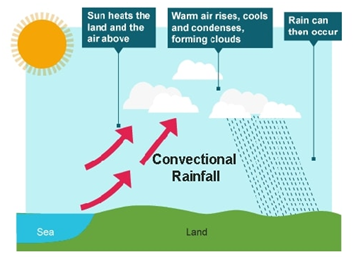
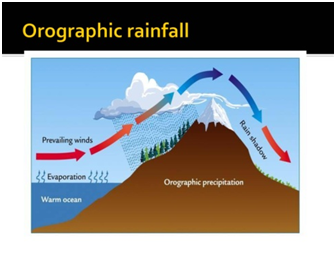
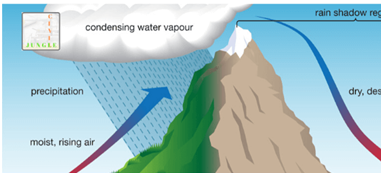
Importance of rainfall
It is very important for the survival of plants and animals. It brings freshwater to the earth’s surface.If rainfall is less- water scarcity and draught occur. On the other hand if it is more, floods take place.
Cyclone- Nature’s Fury
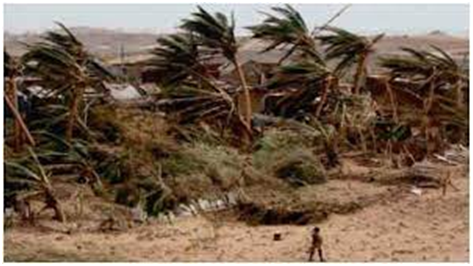
Odisha, located on the eastern sea coast of India, is prone to cyclones that originate in the Bay of Bengal.On 17-18 October 1999, cyclone hits five districts of the state.Another super cyclone occurred on the 29th October 99.The damages caused were mainly due to three factors: wind velocity, rain and tidal surge.The winds of upto 260 km per hour lasted for over 36 hours.These high velocity winds uprooted trees and damaged the Kutcha houses.Rooftops of several industrial sheds and other houses were also blown away.Heavy rains occur under the influence of cyclone for 3 days continuously. These Rains lead to the flooding in the major rivers of Odisha.The cyclonic winds caused tidal waves that swept 20 km inland and brought massive destruction to the coastal areas.7 to 10 m high tidal waves intruded suddenly and cause massive damage to the standing paddy crops.
The Super Cyclone swep the entire cost of Odisha, including the cities of Bhubaneswar and Cuttack and 28 coastal towns. About 13 million peoples were affected. A large number of livestock were killed,standing crops of paddy, vegetables and fruits were heavily damaged. Due to salination caused by tidal surge, large tracts of agricultural land, has turned infertile.Last tracts of sal, teak can bamboo plantation have disappeared. The mangrove forestsbetween Paradeep and Konark vanished.

 Cognizance Publication
Cognizance Publication
